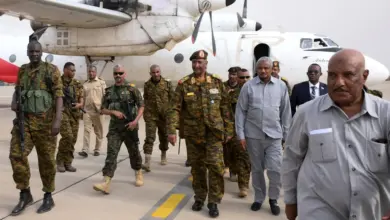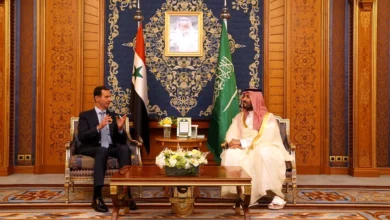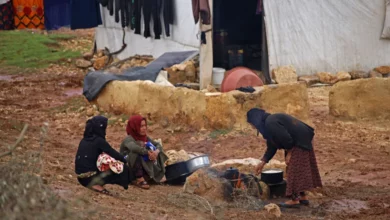
On Sunday, September 29, President Bashar al-Assad declared to the world, via an interview on Italian television, his resolve to clear Syria of chemical weapons – accepting a Russian-brokered deal to avert punitive US action.
That same morning his forces appear to have dropped some of the most powerful conventional weapons yet used in the civil war, in the rebel-held town of Raqqa. Evidence at the scene and witness testimony led Human Rights Watch to conclude that the 14 dead, many of them children, were killed by "vacuum bombs".
As his government works with UN inspectors to destroy its chemical weapons, the scale of Assad's remaining arsenal – and faltering supplies to his enemies – suggest he need not fear giving up poison gas shells of the kind that killed hundreds in rebel areas two months ago and prompted threats from Washington.
Relative armed strength is hard to estimate and is only one factor that may decide a war that has divided Syria on sectarian lines and drawn in rival foreign powers. But Assad's use of such powerful weaponry while international attention is on his chemical disarmament underlines the difficulties facing the rebels – and their Western allies who want to force him out.
Air traffic data suggesting Qatar may have stopped shipping arms to Assad's opponents, and other evidence of supply problems for the rebels despite a US pledge to help, may also help explain recent government gains. Western fears of Islamists in rebel ranks complicates efforts to arm other opposition groups.
"As worries grow over Islamist influence, the rebels seem to be struggling more than they were to get supplies," said David Hartwell, an analyst at IHS Jane's. "At the same time, the government are throwing in everything they've got."
VACUUM BOMBS
Thermobaric or fuel-air explosives, known as vacuum bombs, are a small but fearsome part of the conventional array of artillery, tanks and aircraft Syrian troops have deployed since hostilities broke out in the wake of street protests in 2011.
Like much of Assad's equipment, experts believe the bombs that hit Raqqa were Russian-made. Similar to devices in US stocks, they detonate a cloud of vapour above the ground with a massive blast that sucks in oxygen from a wide area. That kills people in a variety of ways, including by rupturing their lungs.
Used by Russian troops in Chechnya and Americans against the Afghan Taliban, critics say such bombs are too likely to kill civilians to be used in the mainly urban battlefields of Syria.
That has not deterred Assad's forces, which deny having used chemical weapons, from using vacuum bombs on several occasions, according to opposition activists and independent observers who track online videos and other accounts of the fighting in Syria.
Recent evidence of Syrian forces dropping improvised "barrel bombs" and other makeshift explosives has led some analysts to wonder if ordinary supplies are short. But one of the biggest arsenals in the region, intended to both fight Israel and local insurgents, seems unlikely to be exhausted any time soon.
In the three years before fighting broke out, the US Congressional Research Service estimates, Syria agreed more than $5 billion in arms purchases, most from Russia. Many experts believe Russia and Iran have provided more since including spare parts to keep radar, jets and other systems running.
Syrian artillery batteries have sustained barrages on rebel areas lasting for days. In August, as well as the poison gas attacks near Damascus which the government blamed on rebels, the opposition said the Syrian army fired phosphorus and similar agents that burned the skin of civilians hit by it.
The military has also used vacuum bombs before, experts monitoring the conflict say. The attack at Raqqa most likely involved Russian-made ODAB munitions, Human Rights Watch said.
"While the world tries to bring Syria's chemical weapons under control, government forces are killing civilians with other extremely powerful weapons," said Human Rights Watch researcher Priyanka Motaparthy.
The ODAB-500 PM was named last month by arms control group Action On Armed Violence among "Syria's Dirty Dozen" – explosive weapons too powerful or imprecise to be used in populated areas.
It also cited the T-72 tank, the world's biggest mortar the M240 and Grad rockets. Most such munitions have been used by Assad's forces, though rebels have captured and fired some – as well as employing guerrilla tactics like suicide truck bombs.
REBEL PROBLEMS
Assad's troops appear on the back foot in some parts of the country, particularly the east. The Syrian Observatory for Human Rights says 47,000 soldiers and militia fighters loyal to Assad have been killed since 2011, 40 percent of all the war's dead.
But the government has made significant gains, particularly in areas around Damascus that are crucial to its survival.
Several rebel commanders have told Reuters the hunt for weapons was an increasingly costly challenge – and a profitable business for arms smugglers operating from Lebanon and Libya.
US officials say Washington has begun to make good on a pledge made in June to arm the rebels. But shipments have so far largely been limited to small arms such as rifles. Some European governments have supplied "non-lethal" military equipment to opposition groups, such as radio systems and body armour.
Gulf states, particularly Saudi Arabia and Qatar, have provided more, including anti-tank and anti-aircraft missiles.
But disunity among the rebels, including fighting among themselves, has hampered the opposition. And with Turkey and Jordan tightening border controls in alarm at the spread of Islamist groups within Syria, shipments are getting harder.
In the first few months of this year, air traffic control data obtained by the Swedish International Peace Research Institute (SIPRI) and shown to Reuters showed several flights a week to Turkey by Qatari air force C-17 transport aircraft.
But there have been only three in total since the start of August, said SIPRI. It believes the planes carried weapons, including possibly Chinese-made FN-6 anti-aircraft missiles and HJ-8 anti-tank rockets, which appeared in Syria at that time.
In recent months, Saudi Arabia has taken a lead in trying to organise the rebel military force, sidelining its smaller neighbour Qatar, which critics said had helped arm Islamist groups hostile to the West and to the Saudi royal house.
Many weapons arriving now, experts say, appear to come from rich Gulf individuals smuggling in small quantities – often from Libya and going to small hardline Islamist, groups.
The UN deal on Syria's chemical weapons, marking a rare agreement between Moscow and Washington on the conflict, has prompted new efforts to negotiate a peace at Geneva. But there seems little immediate prospect of a halt to the warring sides' efforts to use all arms at their disposal to gain advantage.




